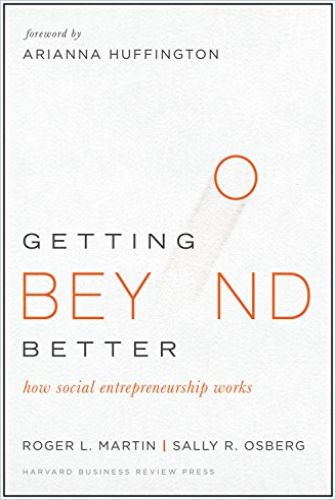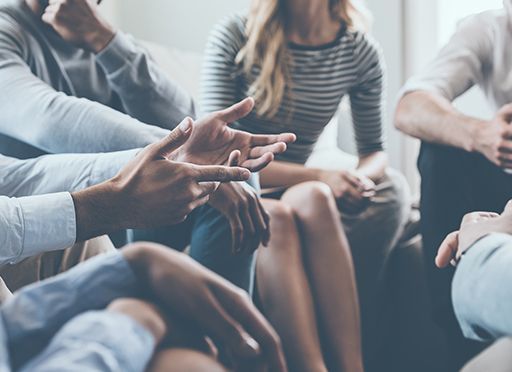Academician Roger L. Martin and executive Sally R. Osberg provide powerful examples of individuals who helped entire communities through social entrepreneurship.

Social Entrepreneurship
When social entrepreneurs recognize a problem that oppresses and marginalizes people, they try to change the system that is giving rise to the problem. Academician Roger L. Martin and executive Sally R. Osberg provide pointers for successful social entrepreneurship and offer a compelling analysis of why and how it can work.
Direct Action
Social service providers act to ameliorate bad conditions, but they don’t fundamentally change systems. For example, they create food banks that feed hungry families, but they can’t change the circumstances that are forcing those families to need a food bank.
By contrast, social entrepreneurs focus on making systemic change.
Carnegie transformed a stable but unhappy status quo, in which advanced knowledge was principally accessible to the rich to a far more optimal state in which knowledge was more equally accessible to all.Roger L. Martin and Sally R. Osberg
Andrew Carnegie, the Gilded Age tycoon and social entrepreneur, was an impoverished Scottish immigrant when he came to the United States. He learned that prominent manufacturer Colonel James Anderson had a large personal library and made his books available to his employees. Carnegie wrote an open letter to Anderson, suggesting that he open his library to other people; Anderson did.
Carnegie later established a foundation that set up free public libraries throughout the United States. At that time, knowledge was available only to those who could afford it. Carnegie made knowledge universally available.
Like Carnegie, social entrepreneurs develop scalable solutions to bring about change and alter the status quo to spread a benefit throughout society.
Social entrepreneurs must navigate three powerful tensions in understanding the world they wish to change: abhorrence and appreciation; expertise and apprenticeship; and experimentation and commitment.Roger L. Martin and Sally R. Osberg
Social entrepreneurs must understand the situation they are trying to change. Then they formulate a vision of a different and better future, develop a model solution and scale it to serve an increasing number of people.
Riders for Health
Motorcycle racers Andrea and Barry Coleman visited sub-Saharan Africa and saw people using wheelbarrows to transport sick women to a health clinic. People were dying by the thousands from diseases for which treatments were widely available.
Since the clinics could obtain medications, the Colemans recognized that a lack of transportation exacerbated this horrible situation. They realized motorcycles could contribute to the solution.
The Colemans started Riders for Health, which trained and equipped motorcycle riders. They forged partnerships with health ministries to provide the maintenance and training necessary for the motorcycle fleets to run. The Colemans realized they had to reach all relevant actors, donors and government agencies. Their vision had to be clear but sufficiently flexible to adapt to change and fluid circumstances on the ground.
Imazon
Deforestation was ravaging Brazil’s Amazon basin. The nation used satellite monitoring to draw attention to the destruction, but authorities could not stop it in real time. This abhorrent situation encompassed the lumber industry, agricultural interests, Indigenous people and their advocates, international commercial interests, and all levels of government.
Adalberto Verissimo founded Imazon to bring these stakeholders together to work on a solution.
Successful social entrepreneurs…must build their models for change with both cost and value in mind, challenging assumptions and finding mechanisms that turn a losing value equation into a winning one.Roger L. Martin and Sally R. Osberg
When Brazil’s president Lula da Silva first assumed office in 2003 [he was re-elected in 2022 after being out of office], his administration looked at newly available data to bring attention to the worst trouble spots in the Amazon basin. It cut off the credit of businesses that were acting destructively in those areas. As enforcement agencies scrutinized the supply chain, major international retailers, such as Walmart and Carrefour, agreed to stop buying merchandise from deforested areas. Deforestation plummeted.
Creativity
Indian activist Kailash Satyarthi sought to end child labor and eliminate human slavery. He established a way to certify products that were manufactured without child labor. Consumers learned to look for that certification, and rates of child labor in South Asia’s rug industry plunged 75%.
Madhav Chavan set up a program to prove that school dropouts could learn to read with only a couple of hours of instruction daily. Chavan expanded his program nationally, scaling it to include volunteer reading teachers in every community. People who completed the program could read and perform arithmetic. In 2012, India embarked on a five-year plan requiring all states to work toward fulfilling new educational goals based on results.
Capital Needs
In some areas of Africa, farmers worked small plots with traditional techniques and technology, harvesting barely enough to feed their families, let alone sell any extra produce and rise above poverty. Andrew Youn founded the One Acre Fund when he saw that farmers needed financing to get the seeds and fertilizers they needed to produce higher yields from their land.
The One Acre Fund offers training, input and processes to double farm production without substantially adding cost. In 2006, it benefited only a handful of families, but that number grew to more than 10,000 and will soon reach 1.5 million.
As enthusiasm for microcredit has grown, so have its critics and challengers, many of them questioning whether the model really does break the cycle of poverty.Roger L. Martin and Sally R. Osberg
Developing a new drug for paying customers in the developed world can cost a pharmaceutical company several billion dollars. To bring medication to poorer countries, The Institute for OneWorld Health (IOWH) repurposes existing drugs that caregivers can use effectively to treat common diseases at minimal cost.
Scale
In 2014, Ebola broke out in Guinea, Liberia and Sierra Leone, killing 10,000 people. The epidemic made global headlines because its case fatality rate was more than 50%, compared to, for example, 1% for flu.
African health ministries whose nations had relatively few doctors contacted the nonprofit Partners in Health (PIH), which provides medical care in the poorest countries and helps them train community health workers.
Quality health care, then, must be designed without depending entirely, or even primarily, on doctors and nurses.Roger L. Martin and Sally R. Osberg
In Haiti, where PIH has saved countless lives, it has only a few thousand staffers to serve more than a million people.
One Person
Roger L. Martin and Sally R. Osberg provide numerous, inspirational examples of how one person, or one small team, can alter the world and change specific examples of, in the authors’ phrase, destructive social equilibriums. Martin and Osberg present the status quo as a powerful force for maintaining negative situations and then show how social entrepreneurs thwart it. Their exemplars of social entrepreneurship demonstrate how to undermine entrenched systems for the good of the poor, oppressed or exploited. The authors present these tales in practical, clear language to teach and inspire. Anyone seeking to move beyond social activism can learn a lot from their work.
Roger L. Martin also wrote The Opposable Mind: How Successful Leaders Win Through Integrative Thinking; When More Is Not Better: Overcoming America’s Obsession with Economic Efficiency; and The Design of Business: Why Design Thinking is the Next Competitive Advantage.





